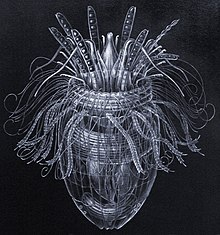Loricifera
| Loricifera Temporal range: Middle Cambrian–Recent (total group) |
|
|---|---|
 |
|
| Pliciloricus enigmaticus | |
| Scientific classification | |
| Kingdom: | Animalia |
| Phylum: | Loricifera |
| Order: |
Nanaloricida Kristensen, 1983 |
| Genera and species | |
Loricifera (from Latin, , corselet (armour) + ferre, to bear) is a phylum of very small to microscopic marine cycloneuralian sediment-dwelling animals with 36 described species, in eight genera. Aside from these described species, there are approximately 100 more that have been collected and not yet described. Their sizes range from 100 µm to ca. 1 mm. They are characterised by a protective outer case called a lorica and their habitat, which is in the spaces between marine gravel to which they attach themselves. The phylum was discovered in 1983 by Roberto Ramos, in Roscoff, France. They are among the most recently discovered groups of Metazoans. They attach themselves quite firmly to the substrate, and hence remained undiscovered for so long. The first specimen was collected in the 1970s, and later described in 1983. They are found at all depths, in different sediment types, and in all latitudes.
The animals have a head, mouth and digestive system as well as a lorica. The armor-like lorica consists of a protective external shell or case of encircling plicae. There is no circulatory system and no endocrine system. Many of the larvae are acoelomate, with some adults being pseudocoelomate, and some remaining acoelomate. Development is generally direct, though there are so-called Higgins larvae, which differ from adults in several respects. The animals have two sexes as adults. Very complex and plastic life cycles of pliciloricids include also paedogenetic stages with different forms of parthenogenetic reproduction. They are not known to be present in the fossil record.
Morphological studies have traditionlally placed the phylum in the vinctiplicata with the Priapulida; this plus the Kinorhyncha constitutes the taxon Scalidophora. The three phyla share four characters in common — chitinous cuticle, rings of scalids on the introvert, flosculi, and two rings of introvert retracts. However, mounting molecular evidence indicates a closer relationship with the nematomorpha.
...
Wikipedia
